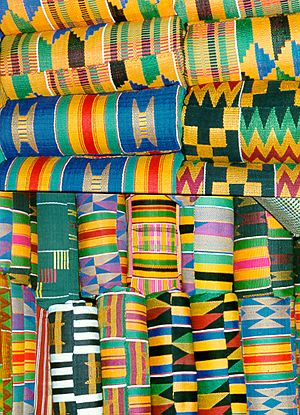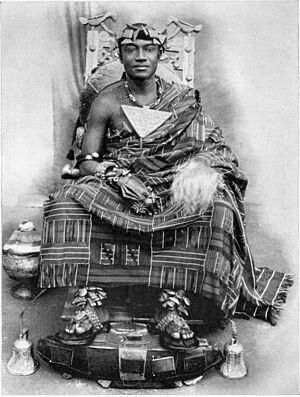Kente cloth facts for kids
Kente refers to a Ghanaian textile made of hand-woven strips of silk and cotton. Historically the fabric was worn in a toga-like fashion by royalty among the Ashanti and Akan. According to Ashanti oral tradition, it originated from Bonwire in the Ashanti region of Ghana. In modern day Ghana, the wearing of kente cloth has become widespread to commemorate special occasions, and kente brands led by master weavers are in high demand. Kente is also worn in parts of Togo and Ivory Coast by the Ewe and Akan people there.
Due to the popularity of kente cloth patterns, production of mass-produced prints with the kente patterns have become popular throughout West Africa, and by extension the whole of Africa. Globally, the print is used in the design of academic stoles in graduation ceremonies.

Etymology
Kente comes from the word kɛntɛn, which means "basket" in the Asante dialect of the Akan language, referencing its basket-like pattern. In Ghana, the Akan ethnic group also refers to kente as nwentoma, meaning "woven cloth". Ashanti folklore includes a story where weavers invented kente by seeking to replicate the patterns of Anansi the spider.
History
West African cultures have been weaving textiles for thousands of years. Archaeological evidence for the oldest form of handloom weaving in Southern Ghana has been discovered at Begho and Bono Manso. Spindle whorls and dye holes discovered in these sites have been dated to the 14th–18th centuries. At Wenchi, spindle whorls have been dated to the 16th–17th centuries.
Asante oral tradition give the origins of Kente to an individual from Bonwire who introduced a loom among the Asante from Bono Gyaman during the reign of Nana Oti Akenten in the 17th century. Another oral source states that it was developed indigenously by individuals from Bonwire during the reign of Osei Kofi Tutu I, who were inspired by the web designs of a spider. In the 18th century, Asantehene Opoku Ware I was documented by Danish agents Nog and L.F. Rømer, to have encouraged expansion in craft work. The Asantehene set up a factory during his reign to innovate weaving in the Ashanti Empire. This was the early stages of Kente production. The Danish agents described the operations of the factory as:
Some of his subjects were able to spin cotton, and they wove bands of it, three fingers wide. When twelve long strips were sewn together it became a "Pantjes" or sash. One strip might be white, the other one blue or sometimes the was a red among them...[Asantehene] Opoke [Ware] bought silk taffeta and materials of all colours. The artists unravelled them.
By the late 18th and early 19th centuries, Kente made out of silk was fully developed in Ashanti. In 1817, Thomas Edward Bowdich noted that weaving in Ashanti had progressed to an extent that cloths were made "in all the varieties of colour, as well as pattern, [and] they were of an incredible size and weight." The word "Kente" might have been applied by the Fante traders to Ashanti fabrics.
Ewe version of Kente is made out of double-woven bands. According to oral tradition, Ewe weaving goes back to the 16th century when weavers were among the migrants who resettled in Ghana from Benin Republic and Western Nigeria. In the 18th century Keta became the centre of weaving among Ewe migrants who had settled in Southern Ghana. The earliest description of weaving among the southern ewe was from a report in 1718 by a Dutch West India Company official during his visit to Keta. By 1881, weaving was a prominent industry among the northern Ewe who had migrated north of the Volta River.
Production
Kente production can be classified by three versions: authentic kente cloth made by traditional weavers, kente print produced by brands such as Vlisco and Akosombo Textile Ltd, and mass-produced kente pattern typically produced in China for West Africans. Authentic kente cloth is the most expensive, while kente print varies in price depending on the production style.
For authentic kente, the towns of Bonwire, Sakora Wonoo, Ntonso, Safo and Adawomase are noted for kente weaving, and are located in the Ashanti region.
Weaving is done on a wooden loom in which multiple threads of dyed fabric are pressed together. Weavers are typically apprenticed under a master weaver or company for a number of years before producing their own patterns. Rolls of cloth are then imprinted with a brand to signify authenticity.
Gender has an influence on cloth production. Weaving kente is traditionally considered a male practice.
Characteristics
There exist hundreds of different kinds of kente patterns. Kente patterns vary in complexity, with each pattern having a name or message by the weaver. Ghanaians choose kente cloths as much for their names as their colors and patterns. Although the cloths are identified primarily by the patterns found in the lengthwise (warp) threads, there is often little correlation between appearance and name. Names are derived from several sources, including proverbs, historical events, important chiefs, queen mothers, and plants. The cloth symbolizes high value.
Ahwepan refers to a simple design of warp stripes, created using plain weave and a single pair of heddles. The designs and motifs in kente cloth are traditionally abstract, but some weavers also include words, numbers and symbols in their work. Example messages include adweneasa, which translates as 'I've exhausted my skills', is a highly decorated type of kente with weft-based patterns woven into every available block of plain weave. Because of the intricate patterns, adweneasa cloth requires three heddles to weave.
Symbolic meanings of the colors
- Black: maturation, intensified spiritual energy, spirits of ancestors, passing rites, mourning, and funerals
- Blue: peacefulness, harmony, and love
- Green: vegetation, planting, harvesting, growth, spiritual renewal
- Gold: royalty, wealth, high status, glory, spiritual purity
- Grey: healing and cleansing rituals; associated with ash
- Maroon: the color of mother earth; associated with healing
- Pink: associated with the female essence of life; a mild, gentle aspect of red
- Purple: associated with feminine aspects of life; usually worn by women
- Red: political and spiritual moods; bloodshed; sacrificial rites and death.
- Silver: serenity, purity, joy; associated with the moon
- White: purification, sanctification rites and festive occasions
- Yellow: preciousness, royalty, wealth, fertility, beauty




